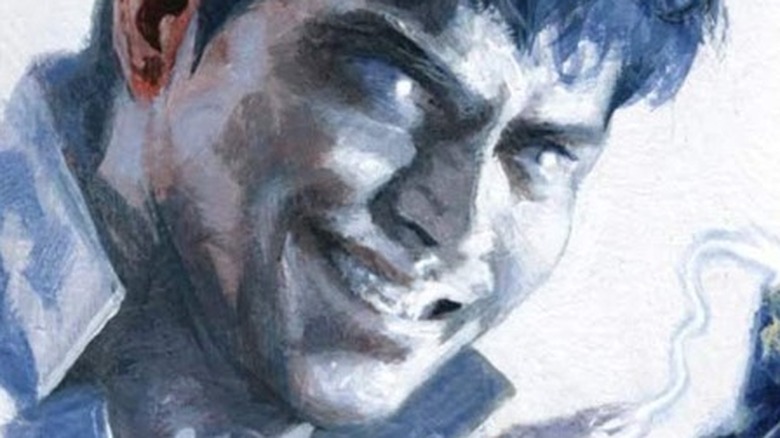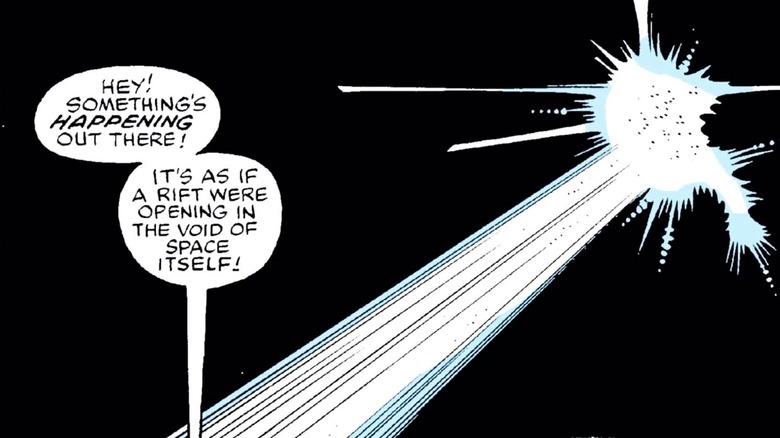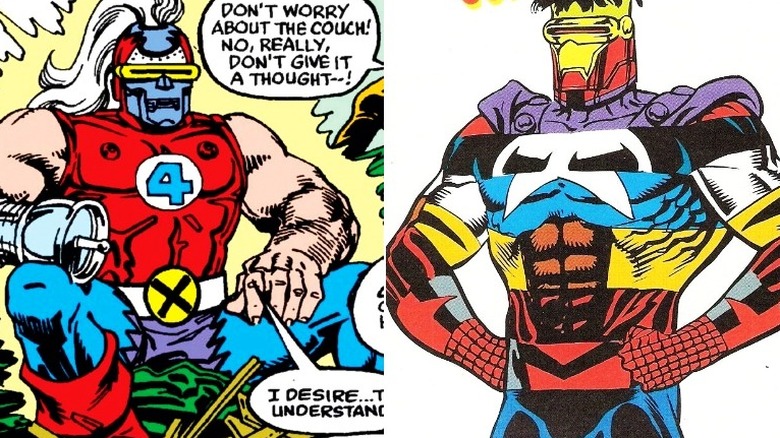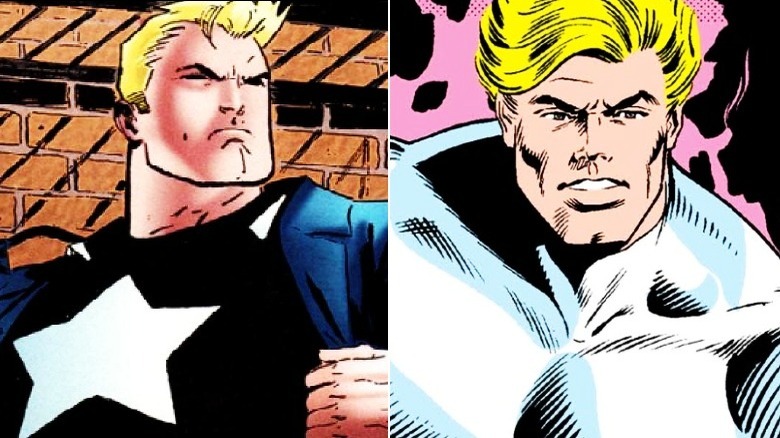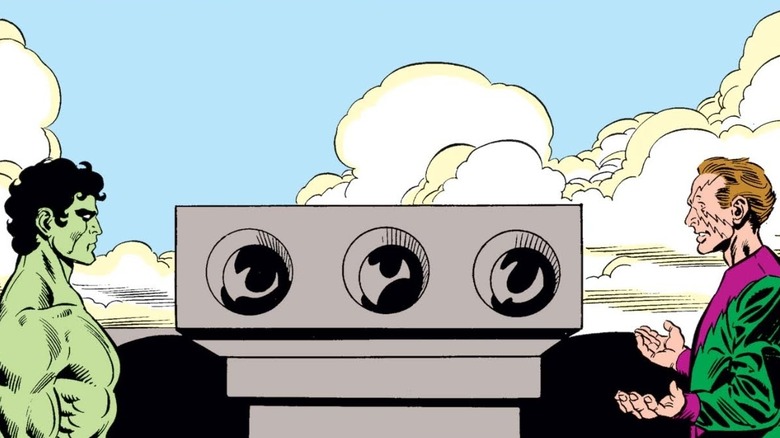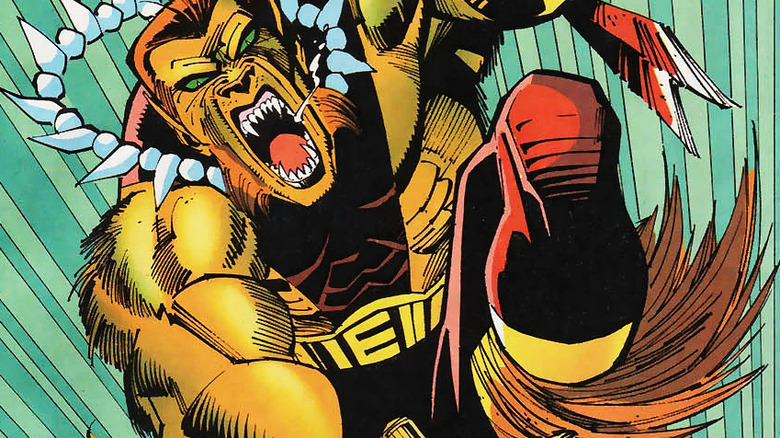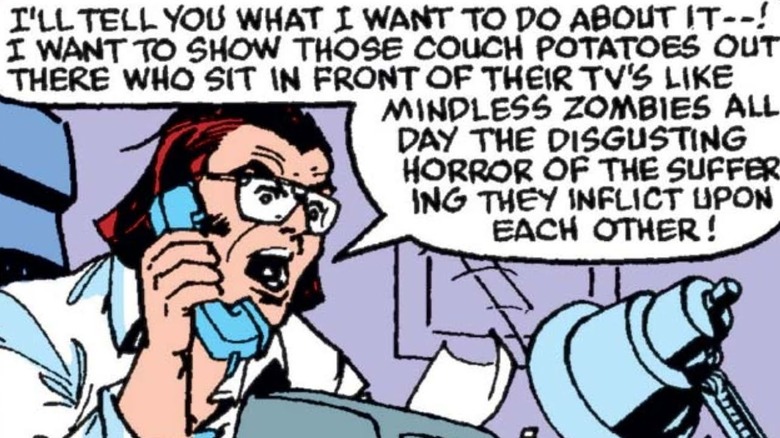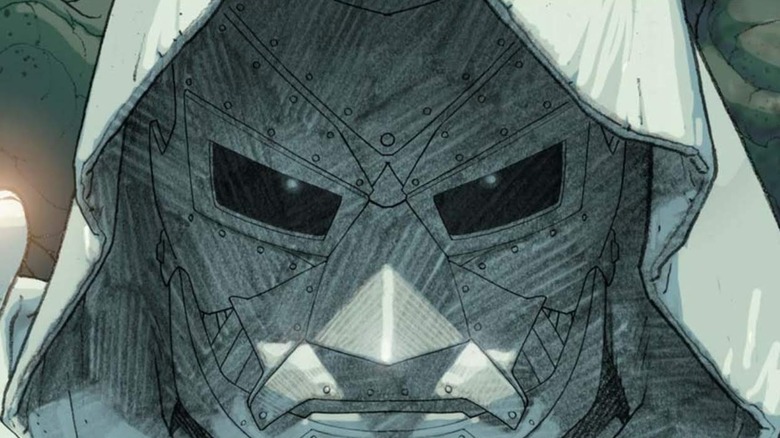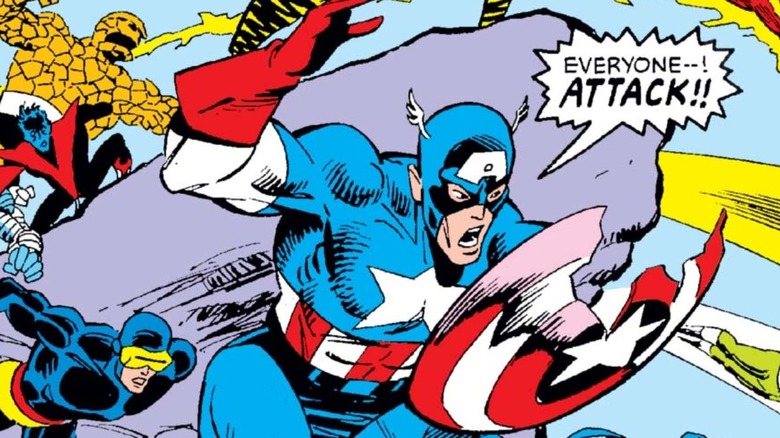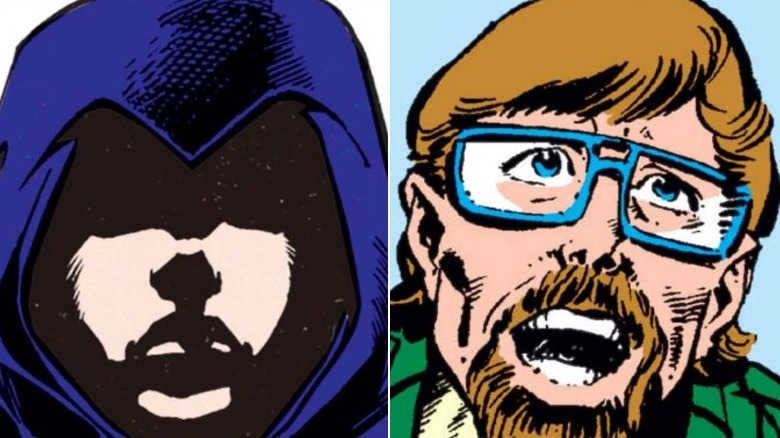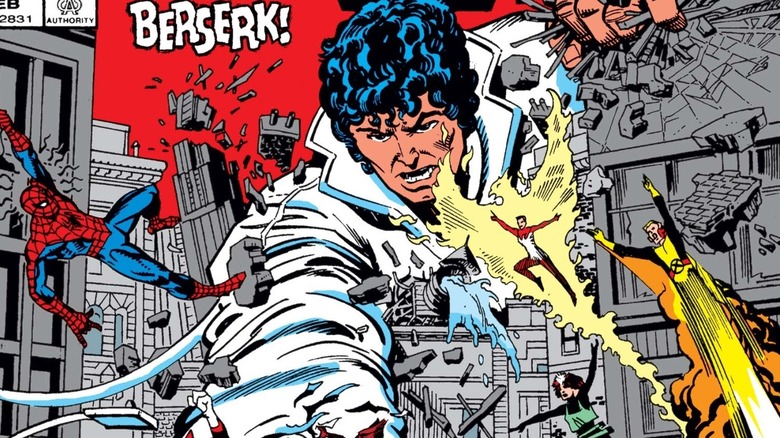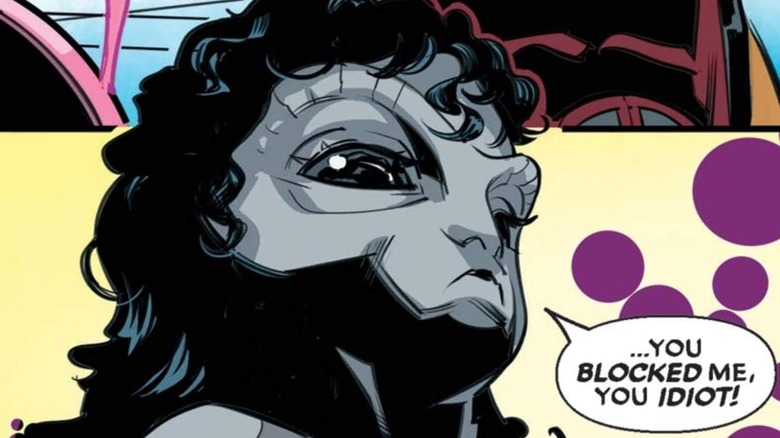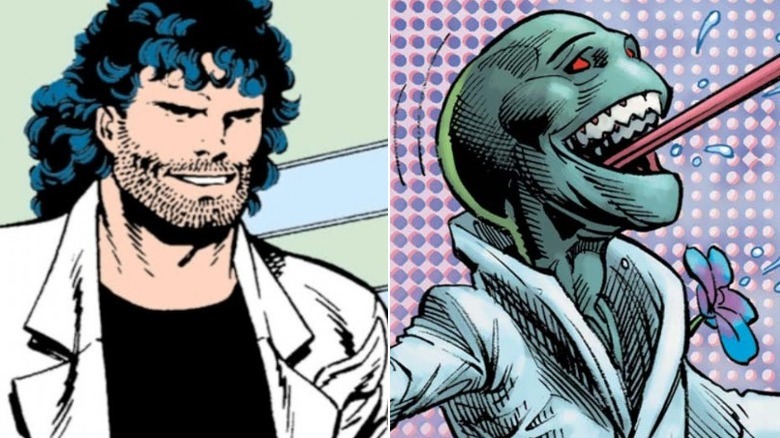The Untold Truth Of The Beyonder
"I am from beyond!" With these words, the Marvel Universe is introduced to the Beyonder, one of the most powerful beings in Marvel Comics' long and storied history. First appearing in the 12-issue limited series "Marvel Super Heroes Secret Wars" (aka "Secret Wars"), the Beyonder, then a formless, virtually immortal being of light inhabiting the entirety of its own dimension, learns of the Marvel Universe and brings several of its greatest heroes and villains to the patchwork planet of Battleworld so they can duke it out, promising the winner(s) anything they choose. The Beyonder returns in "Secret Wars II," becoming a human male on Earth in hopes that emulating humanity can help him figure out how desire works in general.
Despite appearing in only a handful of stories since, the Beyonder has had an enormous impact on Marvel Comics, and has even traversed beyond the comic book medium to appear in animated television shows like "Spider-Man: The Animated Series" and "Avengers Assemble." He is set to be a regular presence in "Marvel's Moon Girl and Devil Dinosaur" (voiced by Laurence Fishburne) and some speculate he could even soon appear in the Marvel Cinematic Universe considering its recent focus on the multiverse, something the Beyonder and his kind have toyed with quite a bit in the comics.
Given that the Beyonder's profile could be on the verge of skyrocketing, it's time to venture into the Beyond Realm and dig up some facts about this strange and unique figure in Marvel lore.
His ever-changing origin
Very little is revealed about the Beyonder's beginnings in the original "Secret Wars" series. Even the Beyonder himself is uncertain of his origins, explaining in "Secret Wars II" #8 that his first memory is of the nuclear explosion that opened the previously-closed off Beyond Realm to the multiverse. Whether the Beyonder existed before then or has simply always existed is a question even he can't answer.
In "Fantastic Four" #319, writer Steve Englehart tries to fill in the blanks by asserting that the Beyonder is one half of the sentient energy used by the similarly-named, even more powerful Beyonders to power reality-warping devices called Cosmic Cubes. This explanation seemingly shuts the book on the Beyonder's origin ... that is, until 2007's "New Avengers: The Illuminati" #3 has Professor Xavier claim the Beyonder is really an Inhuman who also possesses a mutant gene, supposedly explaining his vast might.
Given that Xavier's assertion contradicts everything revealed about the Beyonder previously, however, it's probably little surprise that it's debunked in 2015's "New Avengers" #30, which settles things once and for all by having veteran Avenger Yellowjacket explain that the Beyonder is actually a child member of the Beyonders, rather than energy the Beyonders manipulate.
His first human look resembles a Marvel promotional hero
When the Beyonder first experiments with adopting a human form, he creates a body that combines the looks and costumes of many of the characters he brought to Battleworld in the first "Secret Wars" series. While he abandons the look quickly, the concept of a composite or "combo hero" is reused by Marvel Comics in the 1990s as Combo Man, a hero made by Marvel in conjunction with Combos Stuffed Snacks. While Combo Man may not be omnipotent like the Beyonder, his alter ego, teenager Rick Wilder, does gain the powers of 14 Marvel characters whenever he has himself a Combo snack, as well as a costume that amalgamates the uniforms of said characters.
Even if the Beyonder isn't a direct inspiration for Combo Man, one can't deny that their looks are at least conceptually similar, despite having little else in common. Perhaps during his time as a human, the Beyonder might also have enjoyed the taste of Combos?
He based his main look on Captain America
Once the Beyonder decides the mish-mash superhero/supervillain look isn't for him, he decides to copy the body of the first person he encounters while visiting Earth, namely the villainous Molecule Man. But after tagging along on one of Captain America's adventures and seeing the impact the hero has on others, the Beyonder, seeking to provoke the same response in the people he meets, assumes the appearance of Cap's civilian identity, Steve Rogers, in "Captain America" #308.
While the Beyonder changes his hair and eyebrow color in "Secret Wars II" #3, he's still otherwise emulating Steve's body, as he tells Captain America himself in "The Avengers" #265. Just imagine if he'd put on a Cap costume to go with it — super-villains would be in for quite a shock to encounter a "Captain America" who has infinitely more ways of stopping them than usual!
His other (sometimes better) half
Owen Reece, aka the Molecule Man, precedes the Beyonder by a good 21 years, having first appeared in 1963's "Fantastic Four" #20. Yet he becomes inextricably linked to the Beyonder not long after their first meeting in 1984's "Secret Wars" — perhaps unsurprisingly, considering the Molecule Man's complete control over molecules makes him almost as strong as the Beyonder himself.
It is the Molecule Man, in fact, who unwittingly introduces the Beyonder to the Marvel Universe, as the same incident that gives Reece his powers also creates a small aperture in the Beyond Realm, allowing the Beyonder to learn that he's not the only life form out there. "Fantastic Four" #319 cements their connection even further by revealing that the energy that changes Owen into the Molecule Man comes from the Beyonders and is half the power required to power a Cosmic Cube, while the Beyonder himself is the other half.
"New Avengers" #33, however, alters that reveal, explaining that the Molecule Man is actually one of many identical Molecule Men placed throughout the multiverse by the Beyonder species, and that each version of Reece has enough power to destroy a universe upon his demise.
The obscure Spider-Man villain who can beat him
Some Marvel characters, like Rachel Summers and the Thing, have come close to defeating the Beyonder when he's chosen to deliberately weaken himself. However, only a handful have the power to match the Beyonder at full-strength, a list of names that includes the Molecule Man, Kubik, and the Shaper of Worlds.
And then there's the Puma. Despite not appearing too often these days, the Spider-Man villain (and sometimes hero) whose power is to turn into a "were-puma" can purportedly destroy the Beyonder by becoming "one with the universe" — something he is, in fact, prophesied to do. Puma (alias Thomas Fireheart) comes quite close to doing the deed in "Peter Parker, The Spectacular Spider-Man" #111, but hesitates and breaks his universal connection, reverting to his normal strength levels. Despite the attempt on his life, the Beyonder chooses to spare the Puma, then vanishes, while Fireheart decides to put his Beyonder-hunting days behind him.
The comic book writer he kind of knows
"Secret Wars II" is meant to be satirical, poking fun at and comically critiquing both the world and the comics landscape of the mid-1980s. Take the character Stewart Cadwall, an award-winning comic book writer turned television writer with less-than-flattering views about the state of television and the world at large. The Beyonder visits Cadwall and his girlfriend, Marian, at Cadwall's apartment and turns the TV writer into the costumed, superpowered Thundersword. Unfortunately, Caldwell puts his new gifts to ill use by attempting to "correct" society through indiscriminate property damage ... despite being a self-professed hater of violence.
Cadwall seems to be based on writer Steve Gerber, known for co-creating characters like Howard the Duck and Omega the Unknown. Aside from the name similarities, Cadwall resembles how Gerber looked around the period, and his dialogue is loaded with Gerber's trademark social commentary. As CBR notes, "Secret Wars II" writer Jim Shooter seems to draw significant inspiration from a 1978 "The Comics Journal" interview where Gerber chastises "prettied-up violence" in entertainment media, yet continues to include similarly unrealistic action scenes when writing for television. Just as telling is Cadwall's Thundersword identity, which seems to be a reference to Gerber's 1980 cartoon "Thundarr the Barbarian" (though Thundersword's costume bears a closer resemblance to DC Comics' Weaponers of Qward). At one point in "Secret Wars II," Thundersword even attacks NBC Studios — a likely reference to the fact that the network aired "Thundarr" reruns for a time.
His most persistent rival
Doctor Doom, major enemy to the Fantastic Four and the Marvel Universe in general, is the one non-superpowered human who's vexed the Beyonder time and time again — and vice versa. When the Beyonder recruits Doom among his chosen supervillains to fight on Battleworld, for instance, the not-so-good doctor uses a device to take the Beyonder's might for himself. But the Beyonder tricks Doom into getting his power back by hiding within the body of Doom's loyal ally, Klaw.
Doctor Doom's feud with the Beyonder continues in John Byrne and Joe Sinnott's "Fantastic Four" #288, where Doom, who's possessed civilian Norman McArthur, magically calls upon a power strong enough to reconstitute his destroyed original body. He inadvertently summons the Beyonder, who grants Doom's wish, but not before exacting a little painful payback. The two cross paths again in "Fantastic Four" #319, in which Doom actually seeks the Beyonder's help in regaining the memories the Beyonder had erased from Doom's mind during their previous encounter.
Doom's even become a thorn in the side of the entire Beyonder species. When the Beyonders concoct an "experiment" to destroy every universe in Marvel's multiverse at once by setting all their human "bombs" — e.g. the Molecule Man — to die simultaneously, Doom complicates their plan by killing off several Molecule Men prematurely, luring the Beyonders out so Doom can steal their power. If the Beyonders are like gods, then Doom is their human Prometheus ... only Doom keeps what he steals for himself.
His power breaks Captain America's shield — twice
Though the Beyonder has the power to destroy Captain America's otherwise indestructible admantium/vibranium shield, he's never done so directly. However, his power has broken Cap's mighty discus into pieces twice. The first time is at the end of "Secret Wars" #11, when Doctor Doom, then wielding the Beyonder's abilities, uses an aerial bolt of power to murder every superhero in the Beyonder's contest at once, simultaneously destroying their base and many of their weapons, including the star-spangled shield.
Shockingly, the second person to break the shield with the Beyonder's power is Captain America himself. While the Beyonder does reclaim his power from Doom, some of his energy spreads around Battleworld, giving the heroes on the planet some control over it. Cap, revived with his superhero allies by the alien hero Zsaji, uses the Beyonder's leftover power to fix his broken shield. Yet Cap does so imperfectly, leaving a single vibranium molecule out of place, which causes it to break again years later in "Captain America" #13. Worse still, the fracture causes a chain reaction in every object containing the same vibranium isotope as Cap's shield, and they begin to come apart — and later explode — with increasing force. Luckily, the discus is fixed and the chain reaction is stopped accidentally by the villainous Klaw; fitting, considering how the being whose power had broken Cap's shield once briefly possessed Klaw's body.
He kills Death and replaces her with a guy named Dave
After a life-changing meeting with the Sorcerer Supreme himself in "Doctor Strange" #74, the Beyonder decides to set up a new headquarters in "Secret Wars II" #6 so he can recruit others in his new mission to protect and preserve life. The first to join him is a man named Dave, a journalist for the Sun-Telegraph newspaper who is so inspired by the Beyonder's new calling that he volunteers to help moments into interviewing him. Dave is instrumental in the Beyonder's humanitarian efforts and his goal to "vanquish death"... the latter of which takes a much more literal meaning when Dave has the literal embodiment of Death (who in the Marvel Universe most often takes the form of either a woman or skeleton in a hooded robe) kill herself by consuming a drink charged with the Beyonder's power.
After the Molecule Man strongly criticizes the move, however, Dave reconsiders, pleading the Beyonder to resurrect Mistress Death. When Dave learns that the only way to bring Death back is if the Beyonder kills someone, he volunteers, and his omnipotent friend actually transforms Dave into Mistress Death herself.
His early stories polarized Marvel creators
"Secret Wars" outsold every other 1980s Marvel comic publication, according to "American Comic Book Chronicles: The 1980s." Yet the Beyonder's inaugural story and its sequel, "Secret Wars II," wasn't as popular among the various comic creators involved. Mike Zeck, one of the pencillers of "Secret Wars," found himself frequently going back to the drawing board at writer Jim Shooter's insistence, while "Marvel Comics: The Untold Story" explains that the same thing happened to several artists working on the tie-in comics for "Secret Wars II." Similar incidents occurred on the writing side of things, with Shooter taking famed writer Denny O'Neil's script for "Secret Wars II" tie-in issue "Daredevil" #223 into his own hands, feeling the Beyonder was underused in O'Neil's version and not written how Shooter, the character's co-creator, envisioned him.
The Beyonder himself wasn't that beloved among Marvel creators of the era, either. John Byrne, whose work on "Fantastic Four" and "The Thing" heavily tied into "Secret Wars" and "Secret Wars II," notes on his message board that he's not a big fan of the character, and that the Beyonder's inclusion in the famed "Fantastic Four" #285, in which a child tries replicating the Human Torch's powers with improvised jet fuel and a matchstick to horrifying results, was not his choice. Moreover, "Fantastic Four" #319 writer Steve Englehart notes he wrote the issue as a send-off for the Beyonder at then-series editor Ralph Macchio's request, as Macchio didn't like the character either.
His true appearance may surprise you
Seeing as the Beyonder is basically shapeless light shining through a hole in space when he first gains awareness, it's understandable that he'd believe that to be his natural state, especially since he doesn't remember being anything else. "Secret Wars II" #2 even states that having a body (or "three dimensions instead of an infinite number") is an experience the Beyonder is unfamiliar with.
So it's quite a surprise when, in "Deadpool's Secret, Secret Wars," the titular Deadpool discovers that the Beyonder does have a "default" physical form, going as far back as the first "Secret Wars" series ... and it's not a cube. Instead, the Beyonder, being an infant of the greater Beyonder species, looks unsurprisingly like a smaller version of the adults of his race, only with long, black, curly hair resembling the hairstyle he gives his human form in "Secret Wars II" #3, whereas "grown-up" Beyonders are bald.
The times he was almost a Superman villain
In the comics industry, Marvel's biggest competitor is undeniably DC Comics. Since so many comic book creators who've worked for Marvel have also worked for DC, however, it's not uncommon for writers and artists to sneak in homages and parodies to characters from the rival company. The Beyonder has received such treatment on two prominent occasions, the first of which is in 1987's "Superman" #11 by John Byrne, in which Mister Mxyzptlk, who's also an all-powerful being from another dimension (specifically the Fifth Dimension) strides into Clark Kent's workplace, the Daily Planet, posing as "Ben DeRoy" (get it?) a man from "yonder" who looks almost exactly like the Beyonder's main human form with a little added stubble. At first, DeRoy takes a romantic interest in Lois Lane, but he soon dumps her for, in true Mxyzptlk fashion, a store mannequin, before Superman catches up to him.
Marvel Comics would return the favor in the 2021 storyline "Heroes Reborn" (not to be confused with the 1996 event of the same name), in which it introduces Mr. Beyonder, a green-skinned version of the Beyonder who is enemy to Hyperion — Marvel's most famous analogue of Superman — and shares a couple of traits with Mxyzptlk, including his habit of playing tricks on others with his powers.
The Beyonder's female forms
Though the Beyonder chooses a male identity when becoming human, he illustrates in "Secret Wars II" # 4 that he can alter his sex and gender at will. Thus when he and the Molecule Man merge into the Cosmic Cube they're supposedly meant to be, the Cube — in reality an incubator for cosmic beings — reincarnates the Beyonder as the female energy entity Kosmos, while casting the Molecule Man out and restoring his individuality. Kubik, another Cosmic Cube being, then approaches Kosmos and begins to teach her about the nature of the universe.
Though Kosmos begins as a benevolent being (a change from when she was the Beyonder, whose morality frequently fluctuated), she soon begins losing her grip on reality when she decides to make herself mortal (for reasons unclear) and finds her mind unable to cope. Renaming herself "Maker," the former Kosmos is eventually captured by the Shi'ar Empire's Imperial Guard when she wipes an entire Shi'ar settlement from existence. Imprisoned by Shi'ar justice to serve time in the intergalactic prison known as the Kyln, Maker soon gains enough lucidity to erase the devices used to keep her fellow inmates from revolting, giving them control over the facility. Unfortunately, she's defeated in battle by her fellow prisoner, Thanos, and is sadly killed some time later when the Kyln is attacked by the forces of the insectoid warlord Annihilus.
